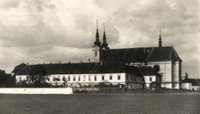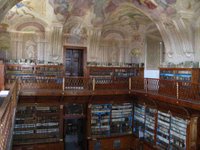The Břevnov MonasteryOn February 14 we visited the Břevnov Monastery in Prague, one of the 254 still working monasteries. The Břevnov Monastery is the oldest male monastery in our country. It was founded by bishop Vojtěch who came here to spread Christianity. In 992 the first 12 monks arrived from the Italian monastery Monte Cassino.
The official date of the foundation and solemn consecrating was January 14, 993 and soon it became very important. After 1344 it was no longer under the Mainz archbishopric and a Saxon monk Dětmar was chosen to be the first bishop. During its history one of the bishops was also Saint Vojtěch who was practising a missionary work after the massacre of his family in 995.
The centre of the monastery is formed by a pre-romanesque Church of Saint Margaret built around the year of 1040 which counts among the most valuable pre-romanesque sights in the Czech Republic and is opened for public now.
During the Hussite wars the monastery and the church were seriously damaged and were rebuilt gradually in Baroque style according to the plan of Kryštof Dienzenhofer. The altarpieces were painted by a famous baroque painter Petr Brandl.
However, the monastery experienced really hard times in the 20th century. Being confiscated by the communist power in 1950 as many other monasteries it went to wreck and ruin. The abbot Anastáz Opasek was unjustly accused of spreading obscurantist ideology and spent whole 50s in jail. With the help of state and foreign monasteries they managed to rebuild it for a millennium of its existence in 1993. On this occasion the pope gave it an honourable title – archabbey. In 1997 Pope John Paul II visited monks of the Břevnov Monastery personally. There have been many repairs since 1999 when a new abbot - Prokop Siostrzonek - was elected.
Except the main mission – living according to the Rule – monks also spend time taking care of the Church of Saint Margaret and the Church of Virgin Mary Victorious on the White Mountain. There is a guide available for visitors and since 1998 the archabbey has released a few books aimed to inform about the monastery life. The representative halls of the monastery are used for special social events – concerts, lectures, presentations and so on.
The Monastery of Emauzy
The Monastery of Emauzy was founded in 1347 by the Czech emperor Charles IV. It was the only monastery with Slavonic liturgical language in the western part of the Charles Empire. The intention of the emperor was to make the relationship among Slavonic tribes stronger and he tried to make up the argument between the Western and Eastern Churches.
The monastery with the church were finished and solemnly consecrated by the archbishop Očko z Vlašimi on March 29, 1372. The origin of the monastery name is unknown. However, there are two theories: Firstly, on that day the Gospel about the appointment of Christ with his Disciples in Emauzy was read. Secondly, once, there was a derelict residence called Emmahaus (the house of Ema). There used to live a Czech Princess, Ema, the daughter of the Burgundy king Konrad.
During the Hussite wars the abbot supported the Utraquists so that the monastery could not be destroyed. Having accepted special precautions the monastery survived also the time of Enlightenment.
After 1880 during the so-called Beuron period the monastery was repaired and rebuilt. The Beuron Art School and the Religious Singing Center were founded by a new abbot from Beuron (south Germany).
In 1918 the Benedictines were forced to leave Czechoslovakia. Only one third stayed there. Generally WWII was a very difficult period for whole Europe. In 1942 the monastery was closed down and the monks were dispersed. At the end of the war the church was destroyed during an American air strike.
After the war in 1950s the buildings were repaired and became the seat of the Czechoslovak Academy of Sciences. A part of the monks lived abroad. In 1964 the roof and two towers of the church were rebuilt in a very modern style. The construction is 4 m high and 1,3 kg of gold was used to gild the spires.
During one of the many reconstructions fragments of murals were discovered. The inscription was written in Croatian Glagolic – the only one and unique evidence of glagolic epigraphy in our country or even in the western Slavonic countries.
On October 1, 1990 the monastery and the church were restored back to life by monks from Benedict’s birthplace – Nocie. Since then the church and the monastery have been used for religious purposes.
The Rule of Saint Benedict (Regula Benedicti)
The Rule of Saint Benedict is a basic work of Benedictine Order. There are main rules and instructions which monks have to keep during their life´s pilgrimage. Many chapters of this book concentrate on rights and duties of monks, moreover we can find there a kind of religious polemics. It also gives practical advice about the monastery life organisation and at the same time it presents a life in the past which followed completely different rules than the life today.
However, this document is also very important from another point of view – we can learn much about everyday life of monks. According to
the Benedictine motto –
Ora et labora – making the monastery economically independent means finding a source of income – work on the fields of a monastery.
Except this work monks also have to spend some time praying and reading. Furthermore, Benedict advices are aimed to inform monks about the quantity and timing of food. He also mentioned such an important thing as the style of clothing. It is influenced mainly by the weather conditions but there are two things that all types of clothes have in common: moderation and low price.
In other parts of the book there are chapters dealing with the day organisation, recruitment of new monks, guests, the course of Mass but also offences and punishments. The Rule is the basic document for life of today´s monks but reading this can be useful for readers who don´t live in a monastery: you can learn a lot and it can offer you a different view of the world.
The Benedictine Order
MonasticismActually, what is monasticism? We can define it as a life which is lived according to the Holy Scripture and following the example of Jesus Christ. The earliest form of monasticism was practised by ancient ascetics. Among these first hermits there was a movement which directly led to the proper monasticism of a solitary type. Leaving the parish they became real monks.
After the 4th century many colonies of hermits started to live in the monasteries. This is the time when most of the religious orders were formed. The Benedictine Order experienced real halcyon days in early Middle Ages while taking part in Christianisation, colonisation and dissemination of knowledge.
According to Benedict the monasticism is the life under the leadership of an abbot and the Rule. The most important points of the Rule are obedience, hearing and silence. With the help of his motto “Ora et labora” Benedict reorganised the monastery life.
Benedict of Norcie
The first biography of Benedict was written by Pope Gregor the Great whose sources were 4 men who had known Benedict personally.
Benedict lived between the years 480 and 543. We don´t know much about his origin but it is sure that he came from a noble family. He studied grammar and rhetoric in Rome but he didn´t finish it. Later he chose a way of loneliness and left Subiaka for Rome. Living a hard life in a cave he lost touch with people and even didn´t know when to celebrate Easter. After 3 years of living in the cave a few monks came to persuade him to become their abbot – this was a really important turning point in his life.
Benedict found a derelict monastery and with the help of other monks he rebuilt it gradually. Giving a special stress on life according to the Rule he wasn´t very popular among his monks. After a failed attempt to poison him he left the monastery and went back to the cave. In a few weeks some men came and watched his way of life. Finally they founded 12 small monasteries.
Being accused of having not enough education for such an important post he left Subiaka and went down in southern direction. He founded a new monastery called Monte Cassino which was a source of inspiration for other benedictine monasteries.
Manual work became a common part of the life in monastery besides praying, contemplation and studying. Benedict knew exactly the day of his death but he wasn´t dying alone.






